TimTaiLieu.vn - Tài liệu, ebook, giáo trình, đồ án, luận văn
Tổng hợp tất cả tài liệu, ebook, giáo trình Khối Ngành Kinh Tế chọn lọc và hay nhất.

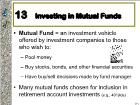 Bài giảng Personal Financial - Chapter 13: Investing in Mutual Funds
Bài giảng Personal Financial - Chapter 13: Investing in Mutual FundsMutual Fund = an investment vehicle offered by investment companies to those who wish to: Pool money Buy stocks, bonds, and other financial securities Have buy/sell decisions made by fund manager Many mutual funds chosen for inclusion in retirement account investments (e.g., 401(k)s)
 28 trang | Chia sẻ: nguyenlinh90 | Ngày: 20/07/2019 | Lượt xem: 910 | Lượt tải: 0
28 trang | Chia sẻ: nguyenlinh90 | Ngày: 20/07/2019 | Lượt xem: 910 | Lượt tải: 0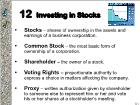 Bài giảng Personal Financial - Chapter 12: Investing in Stocks
Bài giảng Personal Financial - Chapter 12: Investing in StocksStocks – shares of ownership in the assets and earnings of a business corporation. Common Stock – the most basic form of ownership of a corporation. Shareholder – the owner of a stock. Voting Rights – proportionate authority to express a choice in matters affecting the company. Proxy – written authorization given by shareholder to someone else ...
 24 trang | Chia sẻ: nguyenlinh90 | Ngày: 20/07/2019 | Lượt xem: 933 | Lượt tải: 0
24 trang | Chia sẻ: nguyenlinh90 | Ngày: 20/07/2019 | Lượt xem: 933 | Lượt tải: 0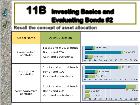 Bài giảng Personal Financial - Chapter 11B Investing Basics and Evaluating Bonds #2
Bài giảng Personal Financial - Chapter 11B Investing Basics and Evaluating Bonds #2People who invest very conservatively They do not get ahead financially over the long term because taxes and inflation offset most of their interest earnings Remember “The Rule of 72”? 72/4% = 18 years 72/8% = 9 years (money doubles much faster)
 24 trang | Chia sẻ: nguyenlinh90 | Ngày: 20/07/2019 | Lượt xem: 894 | Lượt tải: 0
24 trang | Chia sẻ: nguyenlinh90 | Ngày: 20/07/2019 | Lượt xem: 894 | Lượt tải: 0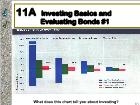 Bài giảng Personal Financial - Chapter 11A Investing Basics and Evaluating Bonds #1
Bài giảng Personal Financial - Chapter 11A Investing Basics and Evaluating Bonds #1Why People Invest To achieve financial goals, such as the purchase of a new car, a down payment on a home, or paying for a child’s education. To increase current income. To gain wealth and a feeling of financial security. To have funds available during retirement years.
 24 trang | Chia sẻ: nguyenlinh90 | Ngày: 20/07/2019 | Lượt xem: 961 | Lượt tải: 0
24 trang | Chia sẻ: nguyenlinh90 | Ngày: 20/07/2019 | Lượt xem: 961 | Lượt tải: 0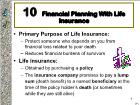 Bài giảng Personal Financial - Chapter 10: Financial Planning With Life Insurance
Bài giảng Personal Financial - Chapter 10: Financial Planning With Life InsurancePrimary Purpose of Life Insurance: Protect someone who depends on you from financial loss related to your death Reduces financial burdens of survivors Life insurance: Obtained by purchasing a policy The insurance company promises to pay a lump sum (death benefit) to a named beneficiary at the time of the policy holder’s death (or sometimes wh...
 24 trang | Chia sẻ: nguyenlinh90 | Ngày: 20/07/2019 | Lượt xem: 1073 | Lượt tải: 0
24 trang | Chia sẻ: nguyenlinh90 | Ngày: 20/07/2019 | Lượt xem: 1073 | Lượt tải: 0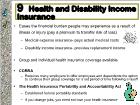 Bài giảng Personal Financial - Chapter 9: Health and Disability Income Insurance
Bài giảng Personal Financial - Chapter 9: Health and Disability Income InsuranceEases the financial burden people may experience as a result of illness or injury (pay a premium to transfer risk of loss) Medical expense insurance- pays actual medical costs Disability income insurance- provides replacement income Group and individual health insurance coverage available COBRA Requires many employers to offer employees and ...
 27 trang | Chia sẻ: nguyenlinh90 | Ngày: 20/07/2019 | Lượt xem: 1060 | Lượt tải: 0
27 trang | Chia sẻ: nguyenlinh90 | Ngày: 20/07/2019 | Lượt xem: 1060 | Lượt tải: 0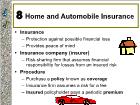 Bài giảng Personal Financial - Chapter 8: Home and Automobile Insurance
Bài giảng Personal Financial - Chapter 8: Home and Automobile InsuranceInsurance Protection against possible financial loss Provides peace of mind Insurance company (insurer) Risk-sharing firm that assumes financial responsibility for losses from an insured risk Procedure Purchase a policy known as coverage Insurance firm assumes a risk for a fee Insured policyholder pays a periodic premium
 24 trang | Chia sẻ: nguyenlinh90 | Ngày: 20/07/2019 | Lượt xem: 1075 | Lượt tải: 0
24 trang | Chia sẻ: nguyenlinh90 | Ngày: 20/07/2019 | Lượt xem: 1075 | Lượt tải: 0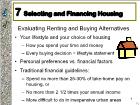 Bài giảng Personal Financial - Chapter 7: Selecting and Financing Housing
Bài giảng Personal Financial - Chapter 7: Selecting and Financing HousingEvaluating Renting and Buying Alternatives Your lifestyle and your choice of housing How you spend your time and money Every buying decision = lifestyle statement Personal preferences vs. financial factors Traditional financial guidelines: Spend no more than 25-30% of take-home pay on housing, or No more than 2 1/2 times your annual income ...
 24 trang | Chia sẻ: nguyenlinh90 | Ngày: 20/07/2019 | Lượt xem: 1140 | Lượt tải: 0
24 trang | Chia sẻ: nguyenlinh90 | Ngày: 20/07/2019 | Lượt xem: 1140 | Lượt tải: 0 Bài giảng Personal Financial - Chapter 6: Consumer Purchasing Strategies
Bài giảng Personal Financial - Chapter 6: Consumer Purchasing StrategiesPractical Purchasing Strategies Timing purchases Price variations by time of year (seasons) Store selection Location, price, selection, services Brand Comparison Private-label or store brands (sold by one chain) vs. national brands Label Information Open dating (shelf life of products)
 24 trang | Chia sẻ: nguyenlinh90 | Ngày: 20/07/2019 | Lượt xem: 998 | Lượt tải: 0
24 trang | Chia sẻ: nguyenlinh90 | Ngày: 20/07/2019 | Lượt xem: 998 | Lượt tải: 0 Bài giảng Personal Financial - Chapter 5B Consumer Credit #2
Bài giảng Personal Financial - Chapter 5B Consumer Credit #2Covered so far Advantages and disadvantages of credit Types and sources of credit Credit capacity (how much you can afford) Credit reports and scores Still to cover The cost of credit Protecting your credit Consumer credit protection laws Debt problems and bankruptcy
 24 trang | Chia sẻ: nguyenlinh90 | Ngày: 20/07/2019 | Lượt xem: 958 | Lượt tải: 0
24 trang | Chia sẻ: nguyenlinh90 | Ngày: 20/07/2019 | Lượt xem: 958 | Lượt tải: 0
Website đang trong thời gian thử nghiệm, chờ xin giấy phép của Bộ TT & TT.

